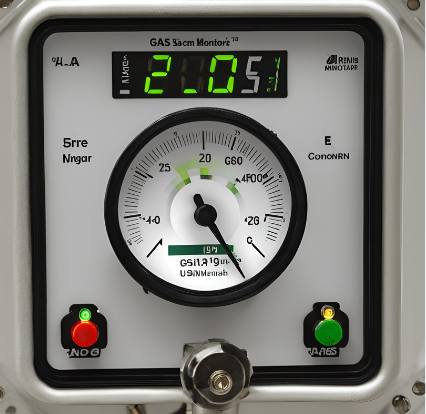A confined space gas monitor is a specialized device used to detect and measure the concentration of hazardous gases within confined spaces. These spaces are typically areas that are not designed for continuous occupancy, have limited entry and exit points, and may pose significant risks due to the presence of toxic, flammable, or oxygen-deficient atmospheres. Examples of confined spaces include storage tanks, silos, sewers, and underground utility vaults.
Importance of Confined Space Gas Monitoring
Confined spaces are inherently dangerous due to their restricted access and potential for hazardous atmospheres. The primary dangers include:
- Toxic Gases: Gases such as hydrogen sulfide (H2S), carbon monoxide (CO), and ammonia (NH3) can be present in confined spaces, posing serious health risks or even death.
- Flammable Gases: Gases like methane (CH4) and propane (C3H8) can create explosive atmospheres if they accumulate in sufficient concentrations.
- Oxygen Deficiency: Normal air contains approximately 21% oxygen. Levels below 19.5% are considered oxygen-deficient and can cause dizziness, unconsciousness, or death.
Given these risks, it is crucial to monitor the air quality within confined spaces to ensure the safety of workers. Confined space gas monitors provide real-time data on gas concentrations, allowing for immediate action if dangerous levels are detected.
Types of Confined Space Gas Monitors
Confined space gas monitors come in various types, each designed to detect specific gases or a combination of gases. The most common types include:
- Single-Gas Monitors: These devices are designed to detect a single type of gas. They are often used when the primary concern is a specific gas, such as carbon monoxide or hydrogen sulfide.
- Multi-Gas Monitors: These monitors can detect multiple gases simultaneously, typically including oxygen, combustible gases, and two or more toxic gases. They are versatile and widely used in various industries.
- Fixed Gas Monitors: These are permanently installed in confined spaces and provide continuous monitoring. They are ideal for areas where gas hazards are a constant concern.
- Portable Gas Monitors: These handheld devices are used by workers to check gas levels before and during entry into confined spaces. They are lightweight, easy to use, and provide immediate readings.
Key Features of Confined Space Gas Monitors
Confined space gas monitors are equipped with several features to ensure accurate and reliable gas detection. These features include:
- Sensor Technology: Gas monitors use various sensor technologies, including electrochemical sensors for toxic gases, catalytic bead sensors for combustible gases, and infrared sensors for specific hydrocarbons. The choice of sensor depends on the gases to be detected and the required sensitivity.
- Alarm Systems: Monitors are equipped with audible, visual, and sometimes vibrating alarms to alert workers when gas concentrations exceed safe levels. These alarms are critical for prompt evacuation and response.
- Data Logging: Many gas monitors have data logging capabilities, allowing them to record gas concentration levels over time. This data can be used for compliance reporting, incident investigation, and trend analysis.
- Battery Life: Portable gas monitors are powered by rechargeable or replaceable batteries. Long battery life is essential for ensuring continuous operation during extended work shifts.
- Durability: Confined space gas monitors are designed to withstand harsh environments. They are often rugged, water-resistant, and capable of operating in extreme temperatures.
Applications of Confined Space Gas Monitors
Confined space gas monitors are used across various industries to protect workers and ensure compliance with safety regulations. Key applications include:
- Oil and Gas: Monitoring for hydrogen sulfide, methane, and other hydrocarbons in storage tanks, pipelines, and drilling sites.
- Wastewater Treatment: Detecting toxic gases like hydrogen sulfide and methane in sewers, treatment plants, and sludge tanks.
- Mining: Ensuring safe air quality in underground mines by monitoring for methane, carbon monoxide, and oxygen levels.
- Manufacturing: Detecting flammable and toxic gases in confined spaces within chemical plants, refineries, and other industrial facilities.
- Construction: Monitoring air quality in confined spaces such as tunnels, trenches, and building foundations.
Regulatory Standards and Compliance
The use of confined space gas monitors is often mandated by regulatory agencies to ensure worker safety. Key regulations include:
- OSHA (Occupational Safety and Health Administration): OSHA’s standards for confined spaces (29 CFR 1910.146) require employers to evaluate and monitor atmospheric hazards before and during entry into confined spaces.
- NIOSH (National Institute for Occupational Safety and Health): NIOSH provides guidelines and recommendations for gas detection and monitoring in confined spaces.
- ANSI (American National Standards Institute): ANSI standards, such as ANSI/ASSE Z117.1, provide best practices for confined space entry and gas monitoring.
Compliance with these regulations is critical for ensuring worker safety and avoiding legal penalties. Employers must provide appropriate gas monitoring equipment, train workers on its use, and establish procedures for responding to gas hazards.
Conclusion
Confined space gas monitors are essential tools for ensuring the safety of workers in hazardous environments. By providing real-time data on gas concentrations, these devices enable prompt detection and response to potential dangers. Understanding the types, features, and applications of confined space gas monitors is crucial for selecting the right equipment and implementing effective safety protocols. Adhering to regulatory standards and best practices further enhances the protection of workers and promotes a safe working environment.





